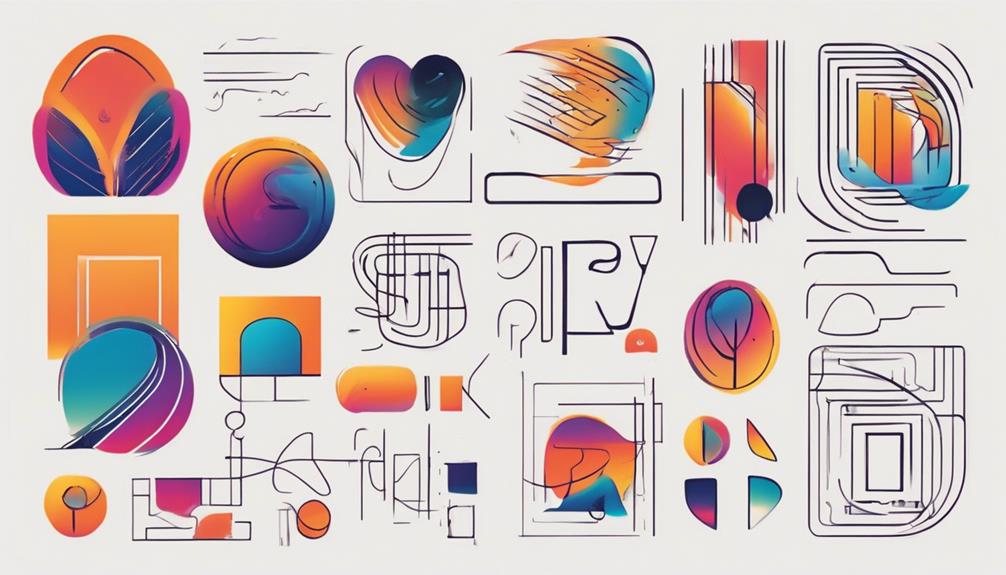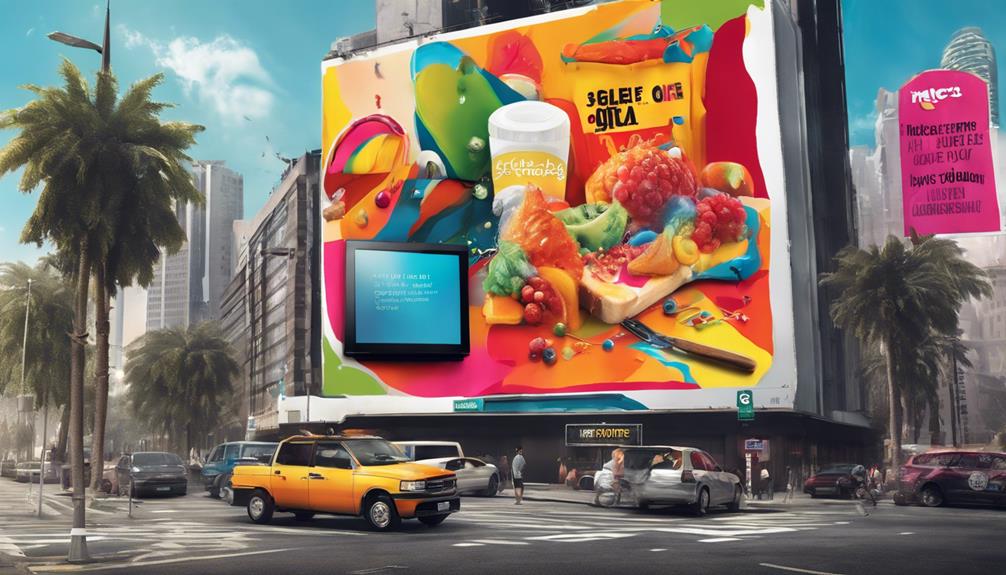The integration of art in advertising is a multifaceted process that goes beyond mere aesthetics. Art serves as a strategic tool for brands to communicate messages effectively, evoke emotions, and establish a unique identity in a crowded marketplace. By exploring the intricate relationship between artistic design and consumer behavior, we can uncover the nuanced ways in which art influences perceptions, shapes brand narratives, and drives engagement. Let's delve into the intricate world of art in advertising to unravel its profound impact on marketing strategies and consumer experiences.
Key Takeaways
- Art in advertising captivates attention and communicates brand messages effectively.
- Visual appeal and design enhance audience engagement and brand recognition.
- Color and image selection influence consumer perceptions and behavior.
- Creative imagery triggers emotional responses, differentiates brands, and boosts marketing success.
Role of Artistic Design in Advertising

Artistic design in advertising serves as a fundamental tool for captivating consumer attention and effectively communicating brand messages. Through the strategic use of art, advertisers can create visually appealing campaigns that resonate with the target audience. Visual elements such as colors, typography, images, and layout play a crucial role in capturing the audience's interest and establishing a strong emotional connection with consumers. Artistic design in advertising goes beyond aesthetics; it influences consumer perceptions, attitudes, and purchasing decisions towards a product or service.
Creative visuals and artistic elements in ads are essential for making a brand stand out in a competitive market and improving brand recall. By incorporating art into advertising, brands can differentiate themselves and leave a lasting impression on consumers. The effective use of art can evoke specific emotions, convey brand values, and enhance the overall impact of the advertising message. In essence, art is a powerful tool that can transform a mundane ad into a compelling and memorable communication piece.
Visual Appeal in Ad Campaigns
Visual appeal in ad campaigns serves as a critical component in captivating the audience's attention and leaving a lasting impact. The strategic use of colors, shapes, and textures in advertising art is instrumental in effectively conveying emotions and messages. Additionally, the creative manipulation of space within ad campaigns aids in organizing visual elements to strengthen brand identity and storytelling.
Color Impact in Ads
In advertising, the choice of colors plays a crucial role in conveying specific meanings and influencing consumer behavior. The color symbolism used in ads can significantly impact brand recognition and consumer behavior. Here are some key points related to color impact in ads:
- Red often symbolizes youthfulness and power in various campaigns.
- Different color choices can affect how consumers perceive and remember a brand.
- Intense colors are commonly employed to suggest speed and appeal to younger demographics.
- Muted color values are favored in sophisticated campaigns to convey elegance.
- Bright colors are prevalent in ads targeting youth audiences to create a vibrant and energetic tone.
Image Selection Strategy
The strategic selection of images in advertising campaigns is a pivotal element in captivating audience attention and effectively communicating brand messages. Visual appeal plays a significant role in engaging the target audience through images that resonate with their demographic. These images should not only align with the brand's values but also evoke the desired emotions in consumers, utilizing visual rhetoric to convey messages effectively. High-quality and relevant visuals can enhance consumer engagement and aid in brand recall within advertising efforts. Moreover, maintaining consistency in image selection across various ad campaigns contributes to building a strong brand identity and fostering recognition among consumers. Therefore, careful consideration and deliberate choices in image selection are fundamental in creating successful advertising campaigns that leave a lasting impact.
Artistic Elements for Branding Success

Effective branding success heavily relies on the strategic incorporation of various artistic elements such as color, shape, and texture in advertising campaigns. Artistic elements play a significant role in creating visually appealing ads that resonate with consumers. Key facts to consider include:
- The creative use of space in advertising art helps convey messages and establish brand identity effectively.
- Art in advertising enhances brand visibility, helps brands stand out, and increases engagement with target audiences.
- Visual content in advertising is remembered for days, making it a key component for successful campaigns.
- Artistic campaigns attract attention, get shared on social media, and continue to garner impressions over time, amplifying the reach and impact of a brand.
Impact of Art on Consumer Behavior
Artistic elements wield a profound influence on consumer behavior through the creation of emotional connections and perceptions in advertising campaigns. Artistic expression in advertising plays a pivotal role in shaping consumer perceptions and behaviors. Visual components like color, shape, and texture are carefully chosen to evoke specific emotions and associations with a product or brand. When art is effectively integrated into advertising, it can trigger strong emotional responses from consumers, influencing their purchasing decisions.
Emotional connections established through artistic campaigns can leave a lasting impact on consumers, leading to increased brand loyalty and affinity. Brands leverage art to not only communicate their message but also to create memorable experiences that resonate with their target audience. By strategically incorporating art into advertising efforts, brands can shape consumer perceptions, ultimately influencing their buying choices. The ability of art to evoke emotions and connect with consumers on a deeper level underscores its significance in driving consumer behavior within the advertising landscape.
Creativity in Ad Creation Process

In the realm of advertising, the process of creating ads involves a dynamic interplay of creativity and strategic thinking. Creative brainstorming sessions are crucial, where teams generate innovative ideas for advertising campaigns. Agencies strategically employ artists, designers, and copywriters to develop visually appealing and engaging ads. Incorporating artistic elements such as illustrations, photography, and typography plays a significant role in enhancing the visual impact in advertisements. Experimenting with colors, shapes, and layouts adds flair and uniqueness to ad designs, capturing the audience's attention. Throughout the creative process in ad creation, there is often a cycle of iteration, feedback, and refinement to produce compelling final visuals that resonate with the target demographic. This iterative approach ensures that the campaign visuals are not only visually striking but also effectively communicate the intended message to the audience.
Artistic Strategies for Memorable Ads
Artistic strategies play a critical role in crafting memorable advertisements that resonate with audiences. Visual storytelling techniques, emotional impact through art, and creative use of imagery are key components that contribute to the effectiveness of ads. By strategically employing these artistic strategies, advertisers can create compelling narratives that leave a lasting impression on consumers.
Visual Storytelling Techniques
Utilizing visual storytelling techniques in advertising elevates the effectiveness of brand messaging by seamlessly integrating artistic elements to create compelling narratives that resonate with target audiences.
- Colors, shapes, and forms are strategically used to convey brand messages effectively in ads.
- Texture and value in art elements add depth and emotion to advertising visuals.
- Creative use of space enhances aesthetic appeal and delivers a compelling message.
- Art in advertising serves as a powerful tool to captivate viewers and evoke emotions.
- Incorporating fine art and Pop Art elements in ads helps leave a lasting impression on consumers.
Emotional Impact Through Art
The incorporation of art in advertising not only enhances visual storytelling but also strategically leverages emotional impact to create memorable and engaging brand experiences for consumers. Artistic strategies play a crucial role in evoking specific emotions through visual elements. By utilizing color psychology, composition, and compelling imagery, advertisers can effectively trigger emotional responses in their target audience. This emotional connection helps ads stand out and leave a lasting impression, increasing brand affinity and loyalty over time. Memorable ads often employ vibrant colors, relatable scenes, and captivating visuals to resonate with viewers on a deeper level. Through these artistic strategies, brands can tap into the emotional realm of consumers, forging strong connections and enhancing brand perception.
| Artistic Strategies | Examples |
|---|---|
| Color Psychology | Strategic use of colors |
| Composition | Balancing visual elements |
| Visual Elements | Compelling imagery |
| Vibrant Colors | Evoke specific emotions |
| Relatable Scenes | Connect with the audience |
Creative Use of Imagery
Creative deployment of captivating visuals and imagery is a fundamental aspect of crafting compelling and enduring advertisements. When graphic designers utilize imagery effectively, they can create ads that not only capture attention but also resonate with the audience on an emotional level. The strategic use of visuals in advertising acts as a powerful form of art that can enhance the perception of a product or service. By incorporating striking visuals, colors, and shapes, brands can differentiate themselves from competitors and leave a lasting impression on consumers. Memorable ads leverage artwork to evoke emotions, convey messages, and enhance brand storytelling. Through effective use of imagery, advertisers can increase brand recognition and influence purchasing decisions.
- Visuals capture attention
- Colors evoke emotions
- Shapes create associations
- Differentiation from competitors
- Lasting impression on consumers
Art Integration for Marketing Success
Art integration in marketing has demonstrated a significant impact on enhancing brand visibility and market competitiveness. Incorporating artistic elements into advertising campaigns can help brands differentiate themselves and capture the attention of consumers effectively. Visual content, when infused with art, tends to leave a lasting impression on viewers, contributing to increased brand recall and recognition. Notably, artistic campaigns have the potential to go viral on social media platforms, extending their reach far beyond traditional advertising methods. Artists like Andy Warhol have shown how art can be used to create iconic and memorable marketing messages that resonate with audiences across generations.
Frequently Asked Questions
Why Is Art Important in Marketing?
Art is vital in marketing due to its ability to enhance brand image, evoke emotions, and create visual impact. Through artistic elements, brands can differentiate themselves, appeal to consumers on an emotional level, and leave a lasting impression. Visual content resonates with audiences, increasing brand visibility and engagement. The use of art in marketing is essential for capturing attention, conveying messages effectively, and standing out in a competitive market landscape.
Why Is Painting Important in Advertising?
Utilizing paintings in advertising is pivotal due to their ability to captivate audiences through engaging visuals, foster brand recognition, and facilitate creative storytelling. The intricate brushstrokes and vivid colors of paintings serve as a powerful medium to convey complex messages and emotions effectively, resonating with viewers on a profound level. By incorporating paintings, brands can differentiate themselves in a crowded marketplace, establishing a strong emotional connection with consumers and enhancing the perceived value of their offerings.
Why Is Drawing Important in Advertising?
Drawing is crucial in advertising for enhancing creativity, fostering visual communication, and promoting branding. It allows for the exploration of various visual approaches, aiding in the development of unique and eye-catching visuals for advertisements. Detailed drawings help in effectively communicating design elements and layouts, while hand-drawn sketches add an authentic and personal touch to advertising art. Drawing plays a pivotal role in ideation and conceptualization before finalizing designs.
How Is Art Used in Media?
Art in media serves as a potent tool for visual storytelling, enhancing brand recognition and fostering emotional connections with audiences. By integrating artistic elements such as graphics, illustrations, and photography, advertisers can create visually appealing content that resonates with viewers. These visual components not only capture attention but also evoke emotions, influencing consumer perceptions and purchase decisions. In essence, art in media plays a pivotal role in crafting impactful advertising messages that leave a lasting impression.
Conclusion
In conclusion, the utilization of art in advertising plays a crucial role in capturing consumer attention, evoking emotions, and enhancing brand storytelling. Through visual elements, creative design, and strategic placement, brands can differentiate themselves in the market and establish a unique identity. Artistic campaigns not only attract but also engage consumers on a deeper level, ultimately leading to successful and impactful advertising efforts. As the saying goes, "A picture is worth a thousand words." 'And a well-executed artistic campaign is worth a thousand sales.'
